Since October 2012, I have taught around 7 continuing adult education classes for St. Louis Community College. These classes were about 3 hours in length. In addition, I have also co-taught or taught 3 climate change classes for the OASIS Center of St. Louis, which is a non-profit educational organization promoting lifelong learning for adults over 50 years old.
I promoted these classes on social media to inspire others passionate about climate change across the U.S. to approach their community college for teach their local citizens about climate change. The response I received from some of climate change communicators was: “Great idea! Can I see a copy of your syllabus?”
I did mail the class agenda to anyone who was interested. I will keep doing this for others asking me the same request. In this blog, I will expand more upon what I cover in my class agenda. Hopefully, this will help others borrow or steal ideas to create their own climate change classes.
Because of this length and details, I had to break this blog up into two parts. I freely admit this blog post will not be for everyone. However, it is my Christmas gift to my Facebook friend, Andrise Bass, and others looking for materials to teach a similar class.
In the Part I of this blog, I covered the first half of the class:
A. My introduction to the class: Why am I teaching this class?
B. Get to know the Partipciants
C. What is Climate Change? What is the Problem?
In that section, I covered the 5 Essential Messages About Climate Change:
• Climate change is real.
• People are causing it this time.
• There is widespread agreement among climate scientists;
more than 95% of scientists are convinced that human-caused climate change is occuring.
• It is harmful to people.
• People can limit it, if we choose.
D. We take a 15 minute break.
This is about the halfway point of my 3 hour class.
In the second half of my class (covered on this blog post), I cover:
How do Americans really feel about climate change? (The 6 Americas Report)
How do you effectively chat with your neighbors, family, friends, and co-workers on climate change?
How do you engage someone who strongly disagrees with you about climate change?
Looking at “unusual suspects” who accept climate change.
Answering climate myth questions.
Ending by showing humorous climate change videos.
E. How do Americans really feel about climate change?
I start this section by introducing the class to 6 of their neighbors: The Yale & George Mason Universities 6 Americas Reports. These reports that give an insight into American perspectives on climate change have been regularly published since July 2010.
The 6 Americas gives the titles for the six different groups as: Alarmed Alice, Concerned Claudia, Cautious Carl, Disengaged Diane, Doubtful David, and Dismissive Dan. I then show the most recent poll from the 6 Americas graphed out from most motivated, most concerned, and highest belief in global warming on the left to least concerned, least motivated, and lowest level of belief on the right.
As of October 2014, the latest poll of the 6 Americas showed the Alarmed (13%), Concerned (31%), Cautious (23%), Disengaged (7%), Doubtful (13%), and Dismissive (13%).
Starting in October 2011, I exchanged e-mails with Dr. Connie Roser-Renouf and Dr. Ed Maibach, two of the authors of the 6 Americas. They each e-mailed their powerpoint slide decks about communicating climate change messaging strategies from Global Warming’s Six Americas.
From their information, I then give a brief description to each of these 6 groups:
Alarmed Alice is highly certain climate change is real, caused by humans and is a serious threat right now. She is uncertain by the effectiveness of her actions and she considered an opinion leader by those around her. She is taking steps as an energy user, consumer, and citizens to advocate for change. Alice supports a wide range of policy responses to address global warming.
Concerned Claudia is very sure global warming, is happening, human caused, but feels less personally threatened that Alice. She believes global warming will harm people 10 or more years from now. She is average in reducing her energy consumption. However, she is well above average in using her consumer power to advocate for change. She supports aggressive government policies, but is currently unlikely to contact her elected officials.
Cautious Carl is only somewhat sure global warming is happening, and he is equally like to see it as human caused or natural. He sees global warming as a distant threat – primarily to other people – that begins to her people in another 25 to 50 years. He is taking average steps to reduce his energy consumption, but isn’t involved in addressing global warming in other ways. However, he is modestly supportive of a range of green policies.
Disengaged Diane thinks global warming may be happening, but she is unsure. She has given it very little thought, not personally important, and doesn’t know much about it. She has done relatively little to reduce her use of energy at home. She has lower that average income and not likely to rely on her own car. In my own conversation with Dr. Ed Maibach, one of the authors of the 6 Americas, he told me ‘The Disengaged are the one segment most likely to be non White, although they are not majority African American.’ Despite her low of personal concern, Diane is more supportive than Carl of a national response to global warming.
Doubtful David doesn’t know if climate change is real or not, but he is pretty sure it is not human-caused. He is not worried about it. He sees it as a very distant threat that won’t harm people for at least 100 years. He is not in favor of a national response to global warming, but he is modestly in favor of a range of energy-saving policy measures. He is improving energy-efficiency in his home.
Dismissive Dan believes global warming is a hoax. He thinks many scientists share his views. He rejects any form of government action against global warming, although he does support efforts to develop renewable energy sources. He is more likely than average to be making energy-efficient improvements to his home.
All of these groups feel very differently about climate change. Therefore, the key question is
How do you effectively reach different segments of the 6 Americas?
In the polling of the 6 Americas, research asked the different segment groups:
“If you could ask an expert on global warming one question, which question would you ask?”
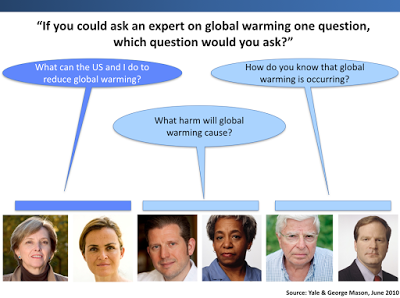 |
| Image Source: climatechangecommunication.org |
The result was that different segments have different questions for climate change experts:
a. Alarmed Alice & Concerned Claudia want to know: “What can the U.S. and I do to reduce global warming?”
b. Cautious Carl & Disengaged Diane want to know: “What harm will global warming cause?”
c. Doubtful David & Dismissive Dan want to know: “How do you know global warming is occurring?”
With Doubtful David and Dismissive Dan, keep in mind that question is a trap. They tend to have deep internal reasoning for rejecting any scientific explanation about climate change. Thus, as I will explain in an upcoming section, it is much better to shift the conversation how David and Dan can save money with energy efficiency. From research and my own personal experience, they are very interested on tips for saving money.
From research from the 6 Americas, these are the topics to engage the different segment groups:
a. Teach Alarmed Alice & Concerned Claudia what actions they can take right now.
b. Tell Cautious Carol & Disengaged Diane stories that bring home the threat of global warming and engage them with characters who are addressing the problem.
c. Teach Doubtful David & Dismissive Dan how they can save money through energy conservation.
F. How do you effectively chat with your neighbors, family, friends, and co-workers on climate change?
In this section, I focus on how engage Disengaged Diane and Alarmed Alice. I leave engaging Dismissive Dan for the next section.
1. Tell Diane & Carl stories that bring home the threat of climate change and show them characters who are addressing the problem.
On December 31, 2012, the St. Louis Post-Dispatch, my hometown newspaper, had this headline that grabbed my attention: One in five kids in parts of St. Louis area struggles with asthma. Underneath the headline was an 8 year old African American boy, Xavier Miles, with a big smile on his face before receiving his spirometry test, which shows the function of the lungs, at his school. The caption stated that “Xavier has asthma and met with various educators who reminded him how to take of himself during an asthma attack.”
The article then mentioned that St. Louis has twice the national average of children suffering with asthma. What causes asthma?
According to the website MedicalNewsToday, environmental factors are one of the top causes of Asthma:
“Pollution, sulfur dioxide, nitrogen oxide, ozone, cold temperatures, and high humidity have all been shown to trigger asthma in some individuals.
During periods of heavy air pollution, there tend to be increases in asthma symptoms and hospital admissions. Smoggy conditions release the destructive ingredient known as ozone, causing coughing, shortness of breath, and even chest pain. These same conditions emit sulfur dioxide, which also results in asthma attacks by constricting airways.”
 |
| Image Source: wikipedia.org |
Just a few months later, St. Louis Public Radio reported “St. Louis area 12th worst among U.S. metropolitan regions for particulate pollution” according to the annual report State of the Air by the American Lung Association. What is causing our dirty air?
It turns out that St. Louis gets around 84% of its electricity by burning coal, that is over twice the national average of 39%. Even worse, Ameren, the local electric utility, operates 4 three coal-fired power plants in the St. Louis metro area, 3 of which run without modern pollution controls.
According to the Clean Air Task Force, retiring one coal plant prevents annually 29 premature deaths, 47 heart attacks, 491 asthma attacks, and 22 asthma emergency room visits.
Just a couple of miles from where I live is the Meramec Coal Plant. It was originally built in 1953. Its health costs to society is larger than profits from production. According to the Environmental Integrity Project, the plant causes about 1,000 asthma attacks and 57 to 100 premature deaths each year.
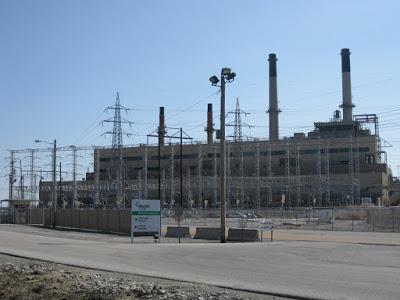 |
| Meramec Coal Power Plant, south St. Louis County, Missour |
The good news for Missouri and the planet is that we don’t need to burn coal. Missouri ranks 13th in available wind resources. In 2008, the small town of Rockport, Missouri, over 1,300 residents, announced that it was the first 100% wind powered community in the United States.
Even more, there are local characters making a difference. In the South County Times, December 14, 2012, was this story, “Living Green With Solar Energy,” about Jim and Judy Stroup. Earlier in 2012, the Stroups installed solar panels on their roof. As a result, their electric bills fell drastically by up to 87%. n 2011, their annual electric bill was $882.60. In a full year of providing up to 87% of his electric needs, Stroup estimated his solar array will cover $767.86 of his electric bill. As a result, their electric bill dropped to roughly $115 a year, or $9.56 a month.
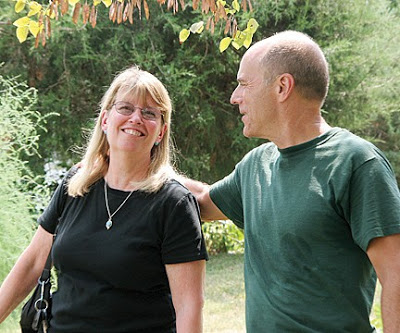 |
| Judy & Jim Stroup photo by Ursula Ruhl, Image source: microgrid-solar.com |
Commenting on his new solar investment, Jim Stroup remarked: “This past month, I spent more beer & pistachios than I did on gas & electric. And I am not a big drinker. It’s amazing how much (solar) cuts down on your bills and how economical it is to install.”
In December 2013, I met up with a friend Jim Seko who drove up to visit me in his electric Nissan Leaf. Jim told me that his electric car was so economical that it would be “too expensive” for him to go back to gas powered car.
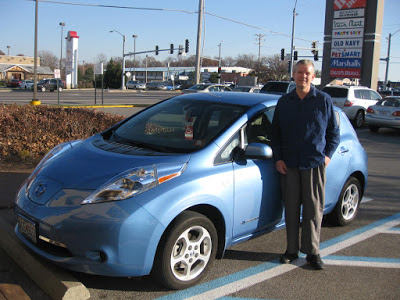 |
| St. Louis resident Jim Seko with his electric Nissan Leaf car. |
2. Tell Alarmed Alice the actions she can take right now.
Unfortunately, Alice feels all alone at home when she reads stories about climate change or sees them on TV. The great news to share with Alice is that she is not alone. As my friend, Larry Schweiger, former President of the National Wildlife Federation, once wrote, “It’s not enough to care; we must link our concern to each other and act collectively”
a. Citizens’ Climate Lobby
One group that has given me hope is Citizens’ Climate Lobby (CCL). It was started in 2007 by retired San Diego real estate broker Marshall Saunders. CCL is a a non-profit, non-partisan, grassroots advocacy organization focused on national policies to address climate change. With over 307 active chapters in the US and worldwide, CCL lobbies Congress in support of its Carbon Fee and Dividend proposal. Its thousands of volunteers do this by building friendly relationships with our federally elected representatives and senators.
 |
| Image Source: citizensclimatelobby.org |
CCL’s purpose:
1. To create the political will for a sustainable climate.
2. To empower individuals to have breakthroughs in exercising their personal and political power.
According to retired NASA climate scientist Dr. James Hansen, “If you want to join the fight to save the planet, to save creation for your grandchildren, there is no more effective step you could take than becoming an active member of Citizens Climate Lobby.”
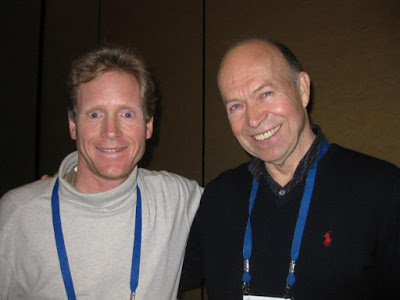 |
| Brian Ettling with NASA climate scientist Dr. James Hanson |
CCL’s goal: get Congress to pass a carbon fee and dividend.
The fee would be placed on carbon-based fuels at the source, which is the coal mine, oil well, or U.S. border. The fee starts at $15 per ton of fossil carbon dioxide emitted. It increases steadily each year by $10, so that clean energy is then cheaper than fossil fuels within a decade. All the money collected is then returned to American households. Two thirds of all households would break even or receive more in their dividend check than they would for the increased cost of energy. A predictably increasing carbon price would send a clear market signal which will unleash entrepreneurs and investors in the new clean-energy economy. It is considered to be a market-based solution geared towards conservative Republicans serving in Congress.
Revenue neutral carbon taxes have been tested in outside of the United States and have proven to be successful. The best case is British Columbia. Since it was first implemented in 2008, British Columbia now has the lowest personal income tax rate in Canada (with additional cuts benefiting low-income and rural residents) and one of the lowest corporate rates in North America.
This tax been amazingly effective in cutting the root of carbon pollution: the burning of fossil fuels. Since B.C. implemented it, fuel use dropped by 16 per cent. In the rest of Canada, it’s rose by 3 per cent.
In 2014, Regional Economic Models, Inc (REMI) did a study of Citizens’ Climate Lobby’s Carbon Fee and Dividend proposal. REMI concluded that CCL’s proposal would create between 2.1 to 2.8 million jobs, reduce carbon pollution by 50%, increase household incomes, save up to 230,000 lives that would otherwise be lost from the pollution of burning fossil fuels, and add up to 1.3 trillion more to the GDP over a 20 year period. Basically, there was no economic case against this proposal.
1. To create the political will for a sustainable climate.
Congress is more likely to take a lobbying group seriously if they are growing in numbers and influence. When I first got involved with Citizens’ Climate Lobby in 2012, there was 74 groups. Now they have 310 groups and over 20,000 volunteers. In June 2015, around 900 Citizens’ Climate Lobby volunteers from all across the United States went to Washington DC for an annual conference. They met with 487 offices. In November 2015, I joined around 140 volunteers to meet with nearly 170 Congressional offices. As the CCL volunteers and I met with the staff with 6 Congressional offices, it felt like they were taking us seriously because of our group size and commitment.
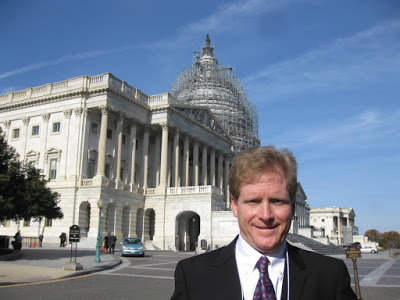 |
| Brian Ettling meeting with 6 different Congressional Offices November 17 & 18, 2015. |
CCL also tries to build positive relations with newspaper editors and the media to build political will. On December 12, 2012, volunteers from Citizens’ Climate Lobby and I met with the editorial board of the St. Louis Post-Dispatch to persuade them to endorse CCL’s carbon fee and dividend. As a result the Post-Dispatch did publish this editorial on December 27, 2012: Editorial: Save the planet. Save Social Security. Save Medicaid. Tax carbon.
 |
| Brian Ettling, Carol Braford, Tom Braford, Steve Valk, and Lucas Sabalka after our meeting with the St. Louis Editorial Board, December 12, 2012. |
2. To empower individuals to have breakthroughs in exercising their personal and political power.
Singer and songwriter Joan Baez once said, “Action is the antidote for despair.”
I can personally attest that Citizens’ Climate Lobby has empowered me to do things I only dreamed I would be doing. In my imagination, I hoped I could write an opinion editorial for the St. Louis Post Dispatch. My CCL volunteer friends challenged me to do this in early April, 2013. That evening, I composed it and submitted it to the Post-Dispatch. It was published on April 19, 2013, For Earth Day, a GOP free-market solution to climate change.
Just one year later, The Post-Dispatch published another oped I wrote for Earth Day 2014, For Earth Day: Asking our elected officials to be climate heroes. The print edition even had a beautiful picture of Crater Lake National Park to go with my opinion editorial.
As we take bold actions by getting involved with groups like Citizens’ Climate Lobby, it does change the world around us. As Mark Reynolds, CCL Executive Director likes to say, “We adamantly believe that politicians don’t create political will, they respond to it.”
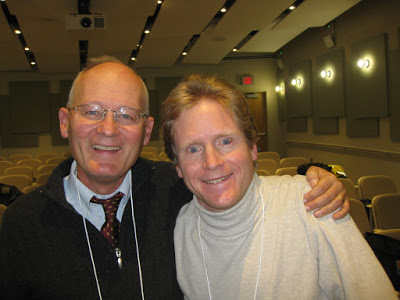 |
| Mark Reynolds, Executive Director of Citizens’ Climate Lobby with Brian Ettling |
b. Sierra Club’s Beyond Coal Campaign
Another group I found to be effective was Beyond Coal Campaign. Their primary objective is to close coal power plants in the United States, including at least one-third of the country’s more than 500 coal plants by 2020, and to replace them with renewable energy sources.
How is this campaign going so far? According to article in Politico this year: “Beyond Coal is the most extensive, expensive and effective campaign in the Club’s 123-year history, and maybe the history of the environmental movement.”
Since this campaign began several years ago, Beyond Coal has helped successfully retire 222 coal plants and 85,500 Megawatts of dirty coal electricity retired. This helps avoid 313 million metric tons of carbon pollution each year.
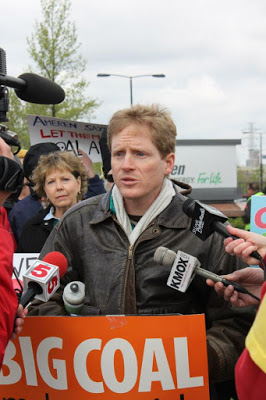 |
| Brian Ettling speaking at a Beyond Coal Rally, April 25, 2013. |
Why move beyond coal?
As I mentioned earlier, the Clean Air Task Force notes that retiring one coal plant prevents annually 29 premature deaths, 47 heart attacks, 491 asthma attacks, and 22 asthma emergency room visits.
Just a couple of miles from where I live is the Meramec Coal Plant. According to the Environmental Integrity Project, the plant causes about 1,000 asthma attacks and 57 to 100 premature deaths each year.
According to U.S. Energy Information Administration*, coal accounts close to 80% of the greenhouse gas emissions from the electric sector. Thus, targeting a reduction in coal emissions and replacing those emissions with renewable energy could produce a huge reduction in carbon pollution.
Even more, according to the Environmental Projection Agency, the Meramec Coal Plant accounts for over 95% of the fixed source greenhouse gas emissions for St. Louis County. Thus, retiring the 62 year old Meramec Coal Plant would go along ways toward cleaning up our local air and reducing local greenhouse gas emissions. Learning all of this in 2013 inspired me to write this oped about Meramec, What keeps me up late at night, that was published in the St. Louis Post-Dispatch on July 10, 2013.
After my involvement with Beyond Coal on this issue, it was great news to read exactly one year later in the St. Louis Business Journal that Ameren to close Meramec power plant. Ameren now plans to convert two units at Meramec to natural gas in 2016, and retiring Meramec completely by the end of 2022.
While this is very positive news for south St. Louis County, Ameren still has 3 other coal plants on the Missouri side of the St. Louis area and 3 others in Illinois side of the St. Louis metro area. Closing Meramec is a good step forward. However, we still have lots to do locally to clean up our air and reduce our carbon pollution from area coal plants. Thus, it is still good to get involved with Beyond Coal.
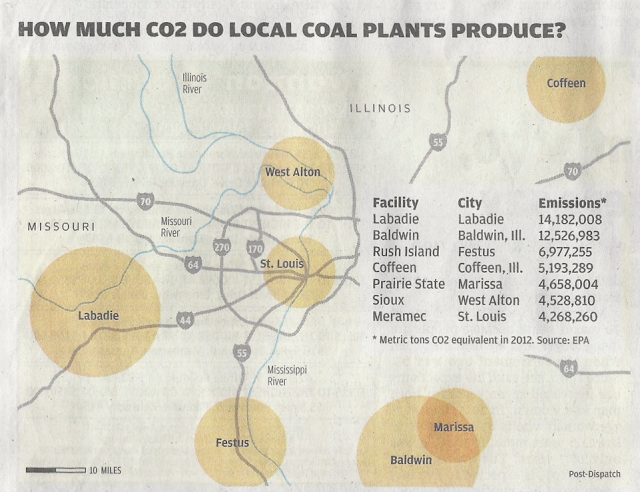 |
| Source: St. Louis Post-Dispatch |
c. 350.org Go Fossil Free Campaign
November 1, 2012, I went to see environmental activist and founder of 350.org, Bill McKibben, give a public lecture at Washington University in St. Louis. During his lecture, I heard him say, “Climate change is the single biggest thing humans have ever done to this planet. One thing must get bigger:
our movement to stop it.”
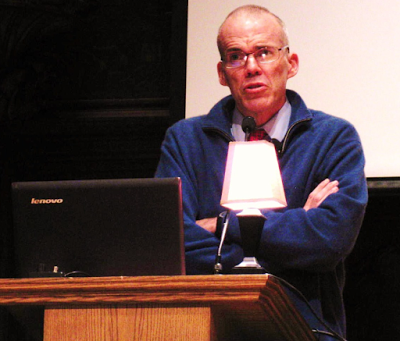 |
| Bill McKibben speaking at Washington University in St. Louis, November 1, 2012 |
During the audience question and answer time with McKibben, I directly asked, “Bill, what is our marching orders once we leave here tonight?”
Bill McKibben responded, “I need all of you to ask your college or university as a student, professor, alumni to divest its financial endowment fund from fossil fuel companies.”
I immediately took this up as a challenge. As an alumni, I wrote a letter to Dr. David Sallee, President of William Jewell College, where I am a 1992 graduate. I mailed this letter on February 8, 2013. I never heard back from my alma mater. Thus, I called several times that summer to speak to Dr. Sallee’s administrative assistant. Dr. Sallee called me directly in August, 2013. I did not persuade him, but I looked at it as an ongoing conversation to plant this idea.
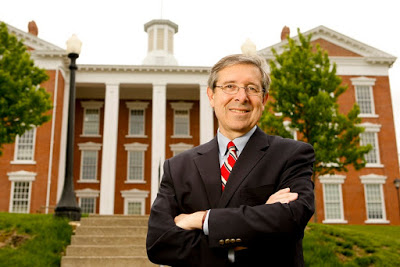 |
| Dr. David Sallee, President of William Jewell College Image Source: jewellalumni.com |
Than exactly one year later, February 8, 2014, the Hilltop Monitor, published an opinion editorial I wrote in their “Sound Off” section to try to persuade the college to divest its endowment from fossil fuels. The college still has not made this commitment yet, but it still felt empowering for me to speak up.
As Dr. David W. Orr, Professor of Environmental Studies, Oberlin College, Ohio, likes to say, “Hope is a verb with its sleeves rolled up.”
To sum up this section, I repeat that in a nutshell:
These are the topics to engage the different segment groups of the 6 Americas,:
a. Teach Alarmed Alice & Concerned Claudia what actions they can take right now.
b. Tell Cautious Carol & Disengaged Diane stories that bring home the threat of global warming and engage them with characters who are addressing the problem.
c. Teach Doubtful David & Dismissive Dan how they can save money through energy conservation.
I then open it up to questions before I focus on how to engage with Doubtful David and Dismissive Dan.
G. How do you engage someone who strongly disagrees with you about climate change?
When I have given talks about climate change over the years, one of my most common questions is: “Yes, I get all of your information, but how can I respond to my uncle, brother-in-law or friend who refuses to accept climate change.”
I start off with the best news of today:
IT IS A WASTE OF TIME TO TRY TO CONVERT CLOSED MINDED DISMISSIVE PEOPLE!
At worst, research shows IT WILL BACK FIRE AND MAKE THEM MORE CONVINCED TO REJECT CLIMATE CHANGE!
I pause and let this information sink in because many of these folks come to my talks looking for a tool to hit back against their dismissive friends or family members.
I then share this advice from Mahatma Gandhi: “Whenever you are confronted by an opponent, conquer him with love.”
For years, my friend and fellow park ranger, Larry Perez, focused on communicating about climate change at Everglades National Park, Florida. In my e-mail exchanges with Larry and access to his powerpoint presentation, Larry gives this advice in his climate change talks:
Know when to disengage when people strongly disagree with you about climate change.
Learn to recognize when emotions and opinion hijack conversation.
During these rare occasions, it is sometimes best to walk away.
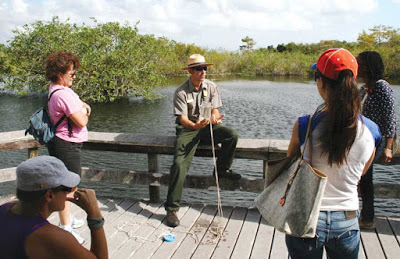 |
| Ranger Larry Perez speaking to park visitors at Everglades National Park. Image Source:www.miamitodaynews.com |
Sometimes you can’t just walk away though if you are in a family situation or giving a presentation to a group of people. You might be forced to respond on the spot for the disengaged and cautious folks in the room looking to still be persuaded about climate change.
Therefore, how do you talk to someone who strongly disagrees with you about climate change?
 |
| Dan Miller Image Source: ithaca.edu |
Quite frankly, it is easy to encounter people who think it is a load of crap. Even worse, it can be a difficult subject to talk about even among friends who agree with you or who are confused about it.
In his TEDx talk, A simple and smart way to fix climate change, Dan Miller, clean technology venture capitalist and frequent climate speaker, confessed chatting about climate change can even be awkward for him. Miller remarked, ‘Society conspires to suppress the discussion of climate change. Someone once said that talking about climate change is like flatulence at a cocktail party.’
To overcome this obstacle for us, George Marshall, co-founder of Climate Outreach, offers these
6 Tips How to Talk to a Climate Change Denier
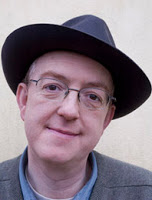 |
| George Marshall Image Source: climateconviction.org |
1. Establish Common Ground
2. Treat them with Respect
3. Own and Hold your own views.
4. Describe Your Own Personal Journey
5. Be aware their worldview.
6. Offer Rewards.
I then go through to the class how I use each of these techniques:
1. Establish Common Ground:
Most people I know love nature and our national parks. If they live in St. Louis like me, we have the common civic pride of our own community. They probably have kids or grandkids and I have nieces and nephews are very significant to me. Besides talking about all these to establish common ground, quoting humorist Mark Twain has been effective for me to lessen the tension. For Mark Twain once said, “Climate is what you expect. Weather is what you get.”
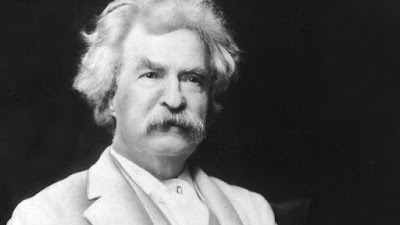 |
| Mark Twain. Image Source: biography.com |
2. Treat them with Respect
George Marshall strongly advises against using the term “denier.” It tends to make people who are dismissive of human caused climate change hostile and defensive. They tend to be even more closed minded then to an idea you would want to share with them about climate change to persuade them.
Marshall advices “consider using the term ‘dissenters’ rather than ‘deniers’ or ‘skeptics.’ I personally like call them “contrarians” or “dismissive,” since the 6 Americas Reports uses the later term.
From personal experience, never call them “crazy.” I had one presentation where a young woman confronted me afterwards. She kept quoting dismissive climate scientist John Christy and kept questioning all of my facts. When she asked me questions, she was not interested in learning from my answers. She only wanted to refute everything I said. When I tried to correct her misstatements, she did not want to hear it. After 15 minutes of this, I was tired and wanted to go home. It was late and my body just wanted to crawl back to my bed for a good night sleep. In my tired and grumpy state, I accidentally said, “You are crazy.”
The young woman then stormed off with her brother and father, and snapped, “He is never going to listen to us.” While my body was very relieved she left, my mind was very nervous. She could complain to the organization that hosted me and I could then not be invited back. Well, the next day I did run into her. Surprisingly, she apologized to me for being too spirited. I apologized to her for calling her crazy. We then laughed in agreement that it would be a boring world if everyone agreed on everything all of the time. I learned a lesson right there never to call anyone crazy.
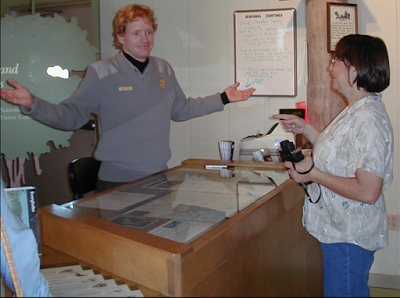 |
| Brian Ettling chatting with a confrontation park visitor in Everglades National Park, in 2004. |
3. Own and Hold your own views.
From this class and an overwhelming amount of scientific peer-reviewed literature, it is very obvious that current climate change is
• Real.
• Us.
• Scientists agree
• It is bad.
• We can limit it, if we choose to act now.
Therefore, we do not have any need to apologize or back down from our views. We can stand tall because the full weight of the science stands behind us.
4. Describe Your Own Personal Journey
None of us, especially me, are born saying,
“There is way too much carbon dioxide in the atmosphere. We have got to solve climate change!”
 |
| Brian Ettling as a baby, 1968 |
For all of us, it is a lifelong process of coming to the realization of climate change.
For me, the awareness happened seeing climate change in my 23 years as a park ranger at Everglades and Crater Lake National Park.
5. Be aware their worldview.
For people who are dismissive of climate change. They tend to see individual actions to reduce their carbon footprint, such as buying local & organic foods, weatherizing their home, and buying a much more fuel efficient car, as way too expensive. They see government actions, such as mandating auto makers to increase the fuel efficiency (CAFE) standards and the EPA Clean Power Plan, as squashing their personal liberty and freedom. They worry about actions on climate change raising their taxes.
Conservative Republican former member of Congress, Rep. Bob Inglis has a great response to those concerns. He starts off by saying, “I share your values.” In an interview with This American Life from May 17, 2013, Inglis “says conservatives feel like their version of the American dream is under attack, that somehow, parents driving their kids through the suburbs in SUVs to soccer practice are being blamed as the cause of global warming, when in fact, everyone uses a lot of electricity and gasoline. Everybody flies on planes.”
 |
| Brian Ettling meeting former Rep. Bob Inglis |
Physicist and energy expert, Amory Lovins, offers these two great responses to objections from conservatives:
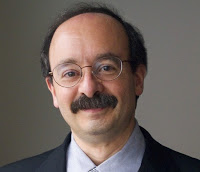 |
| Amory Lovins. Image Source:iee.ucsb.edu |
“Once people understand climate protection puts MONEY back into your pocket because you do not have to buy all that fuel, the political resistance will melt faster than the glaciers.”
“You don’t have to believe in climate change to solve it. Everything we do to raise energy efficiency will make money, improve security & health, and stabilize climate.”
As the 6 Americas informs us, folks who are dismissive about climate change tend to believe that
• climate change is natural.
• action on climate change as a threat to their personal freedom.
• unlikely to change their beliefs about climate change.
However, the good news is that
THEY ARE WILLING TO REDUCE ENERGY USE TO SAVE MONEY.
Thus, the most important tip of all of these is
6. Offer Rewards.
November 30, 2011, I gave a speech, recorded on YouTube, to my South County Toastmasters Club called It’s Easy to be Green. In this speech, I talked in depth about the tips from the title article of the October 2010 issue of Consumer Reports, 7 Ways to Slash Your Energy Bills.
I chatted how Kermit the Frog is wrong. It is easy to be green. Making changes to reduce your home costs is $green$. I added up all the tips in the article to show that following Consumer Reports’ advice could save someone close to a $1,000 a year.
Even more, I shared the story of Nicole Heller that she wrote in ClimateCentral.org on May 12, 2011. To Save Energy, Utilities Tap into Our Competitive Instincts.
The article reported that City of Palo Alto, Calif. recently began including Home Energy Reports in residential utility bills to empower their customers save energy and be greener. Each report compares a household’s energy use with their 100 closest neighbors in homes of similar sizes, and also provides targeted energy conservation tips. The bill reported that the author, Nicole’s energy bill was “ranked as the 23rd-most-efficient household in the neighborhood, based on the previous month’s electricity and natural gas use.” They were listed in the good, but not the great category.
Nicole and her husband wanted to be listed in the Great category, so they immediately dusted off the caulking gun that had been sitting for over two years. This couple then spent the next two hours caulking the windows and weatherizing their home. They then waited patiently for their next utility bill. To their excitement, they were now classified as “Great,” having moved up in the standings to become the ninth-most-efficient house among their neighboring peers, and saving about $50 per month relative to the average household, or about $600 a year.
My fellow Toastmasters reacted very positive to this speech, especially the ones who are very dismissive of climate change. One member, Roy, even told me after my speech, “You know I don’t accept global warming. However, I really liked your speech because you gave me ideas to save money. As everyone knows, I am cheap and like to save money.” Roy and the other Toastmasters even voted for me as the Best Speaker that night among four speeches that were presented.
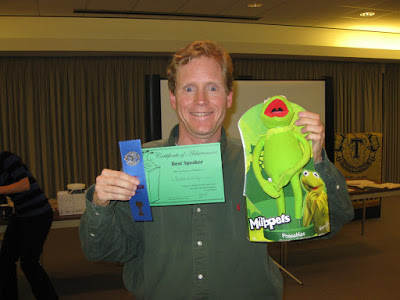 |
| Brian Ettling after he was voted “Best Speaker” by his fellow Toastmasters November 30, 2011. |
I then conclude this section by repeating the 6 Tips How to Talk to a Climate Change Dissenter:
1. Establish Common Ground
2. Treat them with Respect
3. Own and Hold your own views.
4. Describe Your Own Personal Journey
5. Be aware their worldview.
6. Offer Rewards.
With the most important of all these steps Offering Rewards, if one engages a climate change dissenter.
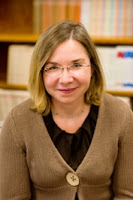 |
| Dr. Katharine Hayhoe Image Source: depts.ttu.edu |
Depending upon the classes I taught, I have sometimes opened this part of for a discussion to practice how to respond to a dissenter with each of these steps. Some classes I taught were not interested in this exercise. That did not bother me at all. At the very least, I open it up to questions that the participants may have at this point.
As conclude this section, I lately have shared this quote from evangelical Christian climate scientist Dr. Katharine Hayhoe. “Climate change is an opportunity to express our faith through love.”
Dr. Hayhoe’s quote reminds me of what I think is George Marshall’s goal for his 6 Tips: reducing the conflict with those who disagree with us about climate through through love and understanding.
I give E. How do Americans really feel about climate change? about 30 minutes and G. How do you engage someone who strongly disagrees with you about climate change? about 15 minutes.
By this time we are up the the 2 hour and 15 minutes in my 3 hour class. At this point, I ask the class for questions. I stress that we have 45 minutes left and I want them to leave with their money’s worth.
Depending upon their interests, I offer other topics to help them feel more informed about climate change:
1. “Unusual Suspects” who accept climate change
2. Climate Zombies! The Mythical Arguments That Never Die!
H. “Unusual Suspects” who accept climate change.
In this powerpoint, I show my collection of organizations and individuals outside of the scientific community who accept climate change. I share direct quotes from them on the need to take action on climate change. These groups or individuals include:
1. U.S. Department of Defense
October 2014, Department of Defense released this report, Climate Change Adaptation Roadmap.
This report warns that as temperatures rise and severe weather increases, food and electricity shortages could create instability in many countries, spreading disease, causing mass migration, and opening the door for extremists to take advantage of fractures in already unstable countries.
Upon the release of this report, Chuck Hagel, Secretary of Defense at that time, stated “Climate change is a ‘threat multiplier’ because it has the potential to exacerbate many of the challenges
we already confront today – from infectious disease to armed insurgencies.”
2. The Catholic Church led by Pope Francis
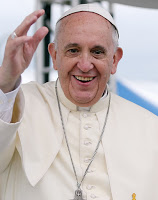 |
| Pope Francis Image Source: en.wikipedia.org |
“On climate change, there is a clear, definitive and ineluctable ethical imperative to act.” – Pope Francis.
“Climate change is a problem we can no longer be left to a future generation.” – Pope Francis.
“At its core, global climate change is not about economic theory or political platforms, nor about partisan advantage or interest group pressures. It is about the future of God’s creation and the one human family. It is about protecting both ‘the human environment’ and the natural environment.” – US Catholic Bishops.
3. Wal-Mart
“Our goal to be supplied 100% by renewable energy is the right goal and marrying up renewables with energy efficiency is especially powerful.” — Wal Mart President & CEO Mike Duke.
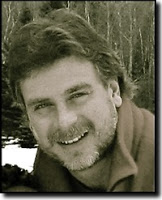 |
| Image Source: conservationhawks.org |
4. Sportsman Todd Tanner
‘If Climate Change Isn’t Real, I’ll Give You My Beretta’ – Todd Tanner, an accomplished angler and serious deer hunter , Field & Stream, February 15, 2012.
5. Insurance Industry
| Image Source: en.wikipedia.org |
“The study being released today by Munich Re, the world’s largest reinsurance firm, sees climate change driving the increase in weather disasters.” – USA Today, October 10, 2012.
6. ExxonMobil
In ExxonMobil‘s Engaging on Climate Change statement:
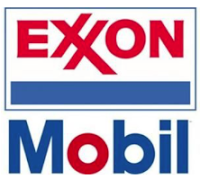 |
| Image Source: bizjournals.com |
“We believe that the risks of climate change warrant action…That is why it will be essential to find ways to reduce the greenhouse gas emissions associated with energy use.”
“ExxonMobil believes a revenue-neutral carbon tax would be a more effective policy option than cap-and-trade schemes, regulations, mandates, or standards. A properly designed carbon tax can be predictable, transparent, and comparatively simple to understand and implement.”
7. Dow Chemical
 |
| Image Source: en.wikipedia.org |
“The climate change threat warrants bold action – and the world must respond with comprehensive, far-reaching solutions. A global climate change strategy is necessary to outline clear steps toward slowing, stopping and reversing the growth of greenhouse gas levels in the atmosphere.”
– Dow Chemical, Energy and Climate Change Statement.
8. Big Business
As of December 1, 2015, 154 companies signed the American Business Act on Climate Pledge. This demonstrated their support for action on climate change and urged that the recent Paris climate change agreement take a strong step forward toward a low-carbon, sustainable future.
Notable companies included Apple, Amazon, AT&T, BestBuy, Coca Cola, Dell, Disney, GE, Hershey’s, HP, IBM, Microsoft, JetBlue, McDonald’s, MGM Resorts, Nike, News Corp, Pepsi, Staples, Target, UPS, Verizon Communications, and many others.
Over 700 businesses have signed the Business for Innovative Climate & Energy Policy (BICEP)’s Climate Declaration asking federal and state policymakers to take action to seize the economic opportunity of addressing climate change.
 |
| Image Source: sustainablebrands.com |
9. American Medical Association
In American Medical Association‘s statement on Global Climate Change and Human Health:
 |
| Image Source: en.wikipedia.org |
“(We) support the findings of the latest Intergovernmental Panel on Climate Change report, which states that the Earth is undergoing adverse global climate change and that these changes will negatively affect public health…
The potential exists for devastating events with serious health implications, including extreme heat and cold events, flooding and droughts, increases in vectors carrying infectious diseases, and increases in air pollution. The health effects from these events should be of concern to the medical community and require action.”
10. NAACP
NAACP ENVIRONMENTAL AND CLIMATE JUSTICE PROGRAM official statement:
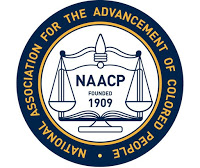 |
| Image Source: naacp.org |
“Global climate change has a disproportionate impact on communities of color in the United States and around the world. The NAACP Environmental and Climate Justice Program was created to educate and mobilize communities to address this human and civil rights issue.”
In November 2012, NAACP released this report, Coal Blooded: Putting Profits Before People. It focused on how coal U.S. coal pollution disproportionally impacts the health, economy and environmental on those who can least afford it – low income communities and communities of color.
11. United Steelworkers Union
 |
| Image Source: en.wikipedia.org |
“The USW has long believed that the goals of stopping the threat of climate change and creating thousands of clean energy jobs can and should be two sides of the same coin.”
— Leo W. Gerard, USW International President.
12. American Meteorological Society (AMS)
Climate Change: An Information Statement of the American Meteorological Society:
 |
| Image Source: en.wikipedia.org |
“There is unequivocal evidence that Earth’s lower atmosphere, ocean, and land surface are warming; sea level is rising; and snow cover, mountain glaciers, and Arctic sea ice are shrinking. The dominant cause of the warming since the 1950s is human activities…
Prudence dictates extreme care in accounting for our relationship with the only planet known to be capable of sustaining human life.”
13. The Weather Channel
Global Warming: The Weather Channel Position Statement:
 |
| Image Source: weather.com |
“More than a century’s worth of detailed climate observations shows a sharp increase in both carbon dioxide and temperature. These observations, together with computer model simulations and historical climate reconstructions from ice cores, ocean sediments and tree rings all provide strong evidence that the majority of the warming over the past century is a result of human activities. This is also the conclusion drawn, nearly unanimously, by climate scientists.”
 |
14. National Geographic
For many years, National Geographic has extensively covered climate change, including the November 2015 magazine devoted entirely to it. Their numerous articles had a deep influence on me.
15. China
Yes, China has been the world’s largest greenhouse gas emitter since 2006. The air pollution was so unhealthy recently that Beijing issued its most severe air pollution ‘red alert’ warning for only the second time in its history.
However, according a June 15 2015, Fortune Magazine article, “China has emerged as the world’s largest market for solar panels and in 2015 is expected to be home to a quarter of the planet’s new energy capacity from solar panels.”
This article went on to say, “China has long been the world’s largest manufacturer or solar panels…
But now China is buying a lot of its own panels, helping give the country dominance in the global solar economy.”
In September 2015, Chinese President Xi Jinping announced Friday that China will develop World’s Largest Cap and Trade Program to reduce the country’s greenhouse gas emissions. August 2014, China stated it will Ban All Coal Use in Beijing by 2020.
According to a 2014 Greenpeace report, “12 of China’s 34 provinces, accounting for 44% of China’s coal consumption, have pledged to implement coal control measures.”
“Green and sustainable development represents the trend of our times.” – China’s President Xi Jinping in April, 2010.
According to January 9, 2015 BloombergBusiness, “China was the biggest single contributor among the major markets for renewable energy.” China invested $89.5 billion, compared with $66 billion for Europe and close to $52 billion for the United States in renewable energy investments.
Clearly, China wants to sell renewable energy to itself and the United States, rather than the U.S. selling renewable energy to China.
17. National Park Service
Director of the National Park Service, Jon Jarvis stated, “I believe climate change is fundamentally the greatest threat to the integrity of our national parks that we have ever experienced…
We have helped the public understand the essential role of predators in the environment by bringing back the wolf and we have shown them that fire is essential to ecosys- tem health. We are unafraid to discuss the role of slavery in the Civil War or the imprisonment of American citizens of Japanese ethnicity during WWII. We should not be afraid to talk about cli- mate change.”
18. St. Louis Zoo
 |
| Image Source: en.wikipedia.org |
Climate Change Position of the Saint Louis Zoo: “Scientific consensus holds that climate change is interrupting natural cycles, causing habitat loss and prompting more extreme weather patterns. All of this affects animals.”
19. Conservatives
This last part is a list of notable conservative scientists or politicians who have publicly stated that climate change is real and currently caused by humans. Included on this list is Dr. Katharine Hayhoe, who has never publicly stated her political beliefs. Thus, she cannot be exactly classified as a conservative. However, she always has been very open about her evangelical Christian faith. She has given numerous climate change talks and interviews to conservative evangelical Christians while sharing her common bond of faith with them.
a. Dr. Richard Alley, Penn State climate scientist, has publicly stated he is a conservative Republican.
b. Dr. Kerry Emanuel, MIT climate scientist, is a Republican leaning voter. However, he received lots of attacks against him rejecting climate science by conservative Republicans. All of those attacks pushed him to more recently thinking of himself as “an independent.”
c. Dr. Barry Bickmore, Brigham Young University geochemist, has publicly stated he is a conservative Republican.
d. Paul Douglas, meteorologist in Minneapolis, Minnesota, is a conservative Republican and an evangelical Christian.
e. Dr. Katharine Hayhoe, climate scientist at Texas Tech University, has never publicly stated her political beliefs. However, she always has been very open about her evangelical Christian faith.
f. George Shultz, former Secretary of State for President Ronald Reagan and conservative Republican, wrote this March 13, 2015 editorial in the Washington Post, A Reagan approach to climate change.
g. Bob Inglis. He was a member of Congress representing South Carolina’s 4th District from 1993-1999 and 2005-2011. The Republican voters in his district voted him out of office in June 2010. One of the top reasons primary voters turned against Inglis for his actions supporting climate change science and legislation.
After I share the story about Rep. Bob Inglis, most classes I showed this YouTube video of Rep. Inglis giving one of his last speeches in Congress. He attacks his fellow GOP colleagues on their stubborn refusal to accept the science of climate change. This video has been very effective in reaching conservative members of the class. It shows someone who agrees with them politically defending the science of climate change.
After this section of “Unusual Suspects” who accept climate change, I typically have 20 to 30 minutes left in the class. This is another opportunity to open it up wide for class questions. I stress again that I don’t want them leaving without getting their money’s worth.
As time is getting shorter, I mention I have another powerpoint that is a collection of the most common climate change myths. Time may not be long enough to go through all of the myths. Thus, I ask them if there is any particular myths they wanted answered.
I. CLIMATE ZOMBIES! SLAYING THE MYTHS THAT NEVER DIE!
In this final section, I have collected the most common misconceptions about climate change that I have heard over the years and put them in this section. I have a title for each myth and background information explaining why each myth is wrong.
I got the idea for calling this section Climate Zombies from University of Georgia climate scientist Dr. J. Marshall Shepherd. In 2013, he did at TEDx talk in Atlanta called Slaying the “zombies” of climate science. This talk was so inspiring for me that I gave my own Toastmasters speech and blog using Dr. Shepherd’s zombie theme.
On that TEDx talk, Dr. Shepherd defines zombie theories as “One of those theories that scientists have refuted or disproven time and time again, but they live on like zombies on in blogs, radio stations, and tweets.”
Here are all of the myths I am ready to address if anyone in the class needs an answer to take home:
“Recently the name was changed from global warming to climate change!”
“We’ve been warmer in the past.”
“Scientists have over exaggerated the threat”
“It has not warmed since 1998.”
“Climate Change is natural.”
“It’s very cold outside, so global warming is not real!”
“There is no way humans can cause change climate.”
“There is nothing we can be do to stop climate change.”
“Taking action on climate change will bankrupt the economy.”
“Climate change is just a theory.”
“In the 1970s all climate scientists believed there was an ice age coming!”
“The Antarctic is Gaining Ice.”
“Wind Turbines kill a lot of birds.”
“We’ll Adapt to climate change.”
After answering some of these questions, I then have a few minutes before the class officially ends. I always offer in any speaking engagement I do to stay around as long as it takes to answer any questions. However, my goal is always to end my class on a positive note.
J. Have Fun!
Climate change can be a very heavy and depressing subject. Thus, I like ending with humor. I do want them leaving with a smile on their face and laughing.
Thus, I have two comedy videos I like to show:
1. Comedian David Crowe doing a comedy routine called “GASOHOLICS” from Comedy Central Standup.
This videos received lots of laughter from the participants and they set a positive mood for everyone as we wrapped up the class.
Final Thoughts
I realize this blog and Part I of this topic are extremely long. Because of the incredibly long length, they are not meant for everyone. These blogs are my Christmas gifts to those who possibly have a dream of teaching a climate change class, but they don’t know where to start gathering up resources. This is also for folks who want to learn more about climate change. To all of these folks, I just wanted to share all of the knowledge that had been given to me over the years. They are treasured gifts. I hope it will be a special gift for you!
Happy Holidays!
Brian Ettling
*Source: U.S. Energy Information Administration, monthly energy review reports, table 12.6, Carbon Dioxide Emissions From Energy Consumption: Electric Power Sector. This was information I received from the Sierra Club. Yes, I looked at the table and computed the math myself to confirm this statistic. I looked at the most recent Monthly Energy Review report pdf file for December 2015.

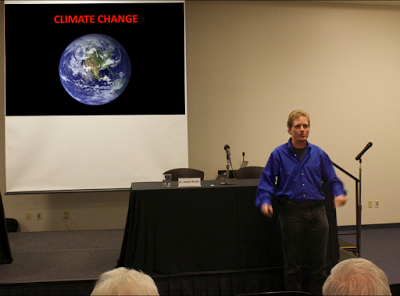

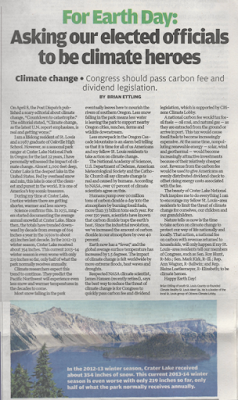
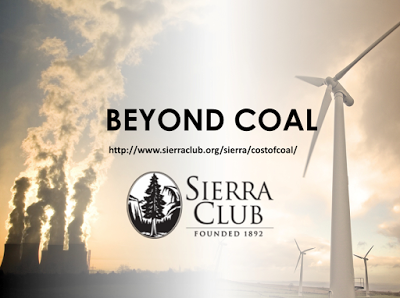

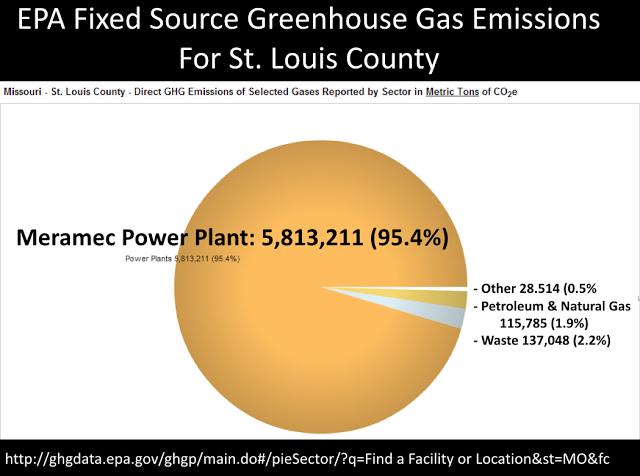
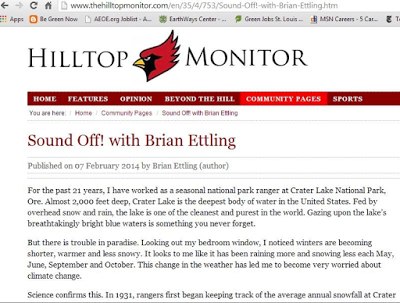
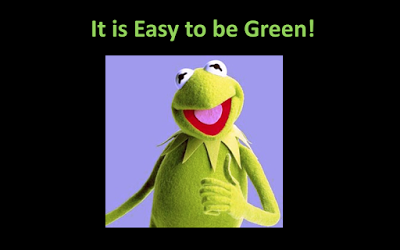




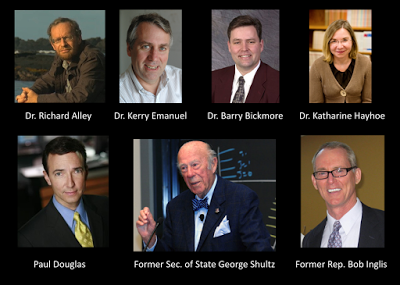

From the bottom of my heart (as a Substitute Naturalist and participant in Earth to Sky training), Thank you, Brian Ettling, for this rich resource. You truly have a gift for communicating climate change!
Brian, you say…"Quite frankly, it is easy to encounter people who think it is a load of crap."
This will then pose the question..why is it so easy to encounter such people?. Why is it so easy to find such dismissiveness. So many just ordinary people….not on any Big Oil payroll or kickbacks. Others are scientists, but are now mostly retired and off the govt's. payroll.
Universally we all seek the truth, we want to know what's going on. Here's where you can find out Brian, by reading what passes for "education" in my country, here…
http://thedemiseofchristchurch.com/2013/03/13/are-we-experiencing-a-communist-infiltration-sponsored-by-the-united-nations/comment-page-1/#comment-1093
Then there's some more, leading to some science…
http://jennifermarohasy.com/2015/04/survey-denying-my-position-on-climate-change/#comment-576587
Here's some entertaining + enlightening stuff….
http://principia-scientific.org/is-no-greenhouse-effect-possible-from-the-way-that-ipcc-define-it.html/
I hope, in the end, this is all good news for you Brian. All the best for the New Year, and for your future.
Mack.
Thank you Unknown and Grant McIntosh for your comments. I sure do appreciate that. It is important that we keep engaging people on the problem of climate change. Even more, we must offer folks solutions and that gives them hope and options for them to take action. All the best to you!
A lot of really neat supporting materials!!